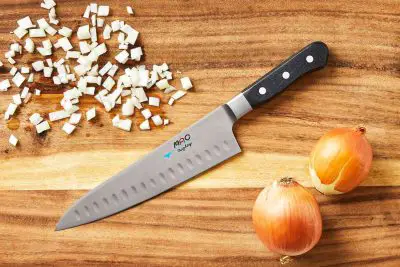Exploring the world of culinary craftsmanship? Well, one of the fundamental aspects that every budding chef or home cook should be aware of is Chef’s knife dimensions. The size and dimensions of a chef’s knife play a crucial role in determining its versatility and functionality in the kitchen. Join me as we delve into the world of Chef’s knife dimensions and uncover how these measurements can impact your cooking experience.
The most common chef’s knife has a blade length ranging from 6 to 10 inches (15 to 25 centimeters). This size strikes a balance between precision and maneuverability, allowing for a wide range of cutting tasks, from slicing and dicing to chopping and mincing. The blade is typically about 1.5 to 2 inches (3.8 to 5 centimeters) wide at its widest point, which provides ample space for knuckle clearance while chopping.
The length and width of the blade make it suitable for a variety of ingredients and cooking techniques, making it an indispensable tool for both professional chefs and home cooks.
What is the standard length of a chef’s knife?
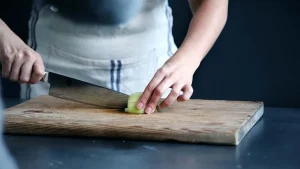
The standard length of a chef’s knife, also known as a cook’s knife or French knife, typically falls within a range of 8 to 12 inches (20 to 30 centimeters). However, the most common and widely preferred length for a chef’s knife is around 8 to 10 inches (20 to 25 centimeters). This range strikes a balance between versatility, control, and ease of use, making it suitable for a wide range of kitchen tasks.
Here are some key points to consider regarding the standard length of a chef’s knife:
- Versatility: The 8 to 10-inch length is versatile enough to handle a variety of cutting tasks in the kitchen. It can be used for chopping, slicing, dicing, mincing, and even some precise tasks like boning or filleting.
- Control: A chef’s knife of this length provides a good level of control and maneuverability. Chefs can comfortably use it for extended periods without experiencing hand fatigue.
- Balance: The standard length chef’s knife typically has a balanced weight distribution, which enhances its usability. It allows for a rocking motion when chopping and slicing, making it easier to execute these techniques with precision.
- Safety: Longer knives can be intimidating for some users, especially those who are less experienced in the kitchen. A standard 8 to 10-inch chef’s knife strikes a balance between being long enough to handle most tasks and not too long to pose safety concerns.
- Storage: These knives are also easier to store in most knife blocks, magnetic strips, or knife rolls. Longer knives may require special storage solutions.
- Maintenance: Standard-sized chef’s knives are relatively easy to maintain and sharpen. They are also less prone to becoming dull quickly compared to shorter knives.
It’s worth noting that the choice of knife length may vary depending on personal preferences and the specific cooking tasks you frequently perform. Some professional chefs prefer longer knives for certain tasks like slicing larger cuts of meat, while others find shorter knives more comfortable for precise work.
Are chef’s knives available in different blade lengths?
Yes, chef’s knives are available in various blade lengths to cater to different preferences, cooking styles, and tasks. While the standard length for a chef’s knife falls within the 8 to 10-inch range, there are shorter and longer options, each with its own set of advantages and best-suited applications. Here is comprehensive information on the availability of chef’s knives in different blade lengths:
- Short Chef’s Knives (6 to 8 inches):
- Advantages: Shorter chef’s knives offer greater maneuverability and control. They are excellent for precise tasks like peeling, trimming, and slicing small fruits and vegetables.
- Best Uses: Ideal for cooks who prefer a lighter and more agile knife. These knives are also suitable for those with limited countertop space.
- Standard Chef’s Knives (8 to 10 inches):
- Advantages: The 8 to 10-inch chef’s knives are the most versatile and widely used. They strike a balance between length and control, making them suitable for a wide range of cutting tasks, including chopping, slicing, dicing, and mincing.
- Best Uses: These knives are the workhorses of the kitchen and are recommended for most home cooks and professional chefs. They excel in everyday cooking and culinary tasks.
- Long Chef’s Knives (10 to 12 inches):
- Advantages: Longer chef’s knives are excellent for slicing larger cuts of meat or fish with a single, fluid motion. They cover a larger cutting surface, which can be beneficial when working with big ingredients.
- Best Uses: Preferred by professional chefs for tasks like carving and breaking down large roasts or whole fish. They are less common in home kitchens but can be valuable for specific applications.
- Extra-Long Chef’s Knives (12+ inches):
- Advantages: Extremely long chef’s knives are typically reserved for specialized tasks and experienced chefs. They provide extended reach and can handle large quantities of ingredients.
- Best Uses: These knives are found in professional kitchens and are used for tasks such as slicing cured meats or breaking down large primal cuts of meat. They are not recommended for novice cooks due to their size and weight.
When choosing a chef’s knife, consider your cooking style, the types of dishes you prepare most frequently, and your level of experience. The right blade length can significantly impact your comfort and efficiency in the kitchen. It’s also important to invest in a high-quality chef’s knife with a comfortable handle and a sharp, durable blade, regardless of the length you choose, as the overall quality of the knife will affect its performance and longevity.
How does the blade width of a chef’s knife affect its performance?
The blade width of a chef’s knife is a critical factor that affects its performance. A wider blade provides more surface area for chopping and slicing, making it easier to cut through large pieces of food. It is also better suited for tasks that require a lot of force, such as cleaving bones or chopping through thick vegetables. However, a wider blade can be more difficult to maneuver and control, especially in tight spaces.
A narrower blade, on the other hand, is more agile and easier to control. It is also better suited for tasks that require precision, such as mincing herbs or dicing vegetables. However, a narrower blade may not be as effective at cutting through large pieces of food or performing tasks that require a lot of force.
The ideal blade width for a chef’s knife depends on the individual user’s preferences and the types of tasks they typically perform. If you are unsure which blade width is right for you, it is best to start with a medium-width blade, which offers a good balance of versatility and performance.
Here is a more detailed overview of how the blade width of a chef’s knife affects its performance:
Cutting and slicing: A wider blade provides more surface area for cutting and slicing, making it easier to cut through large pieces of food. It is also better suited for cutting through hard or dense foods, such as winter squash or root vegetables. However, a wider blade can be more difficult to maneuver and control, especially when slicing thin pieces of food.
Mincing and dicing: A narrower blade is more agile and easier to control, making it better suited for tasks that require precision, such as mincing herbs or dicing vegetables. It is also less likely to crush or bruise delicate foods. However, a narrower blade may not be as effective at cutting through large pieces of food or performing tasks that require a lot of force.
Chopping and cleaving: A wider blade with a thicker spine is better suited for tasks that require a lot of force, such as chopping through thick vegetables or cleaving bones. It is also less likely to bend or break under pressure. However, a wider blade can be more difficult to maneuver and control, especially in tight spaces.
Overall, the best blade width for a chef’s knife depends on the individual user’s preferences and the types of tasks they typically perform. If you are unsure which blade width is right for you, it is best to start with a medium-width blade, which offers a good balance of versatility and performance.
What is the ideal weight for a chef’s knife?
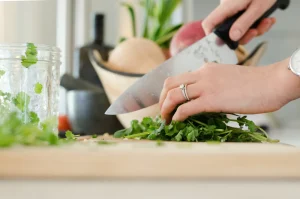
The ideal weight for a chef’s knife is a matter of personal preference, but most professional chefs prefer a knife that weighs between 8 and 12 ounces. A heavier knife provides more momentum, which can be helpful for tasks such as chopping through thick vegetables or cleaving bones. However, a heavier knife can also be more tiring to use, especially for extended periods of time.
A lighter knife is more agile and easier to control, making it better suited for tasks that require precision, such as mincing herbs or dicing vegetables. However, a lighter knife may not be as effective at cutting through large pieces of food or performing tasks that require a lot of force.
If you are unsure which weight is right for you, it is best to start with a medium-weight knife, which offers a good balance of versatility and performance. You can also try out different knives at a kitchen supply store to see what feels most comfortable in your hand.
Can you explain the difference between a Western-style and a Japanese-style chef’s knife in terms of dimensions?
Western-style and Japanese-style chef’s knives differ in several dimensions, including blade shape, length, and overall design. Here are the key differences in terms of dimensions:
- Blade Shape:
- Western-style Chef’s Knife: Western-style chef’s knives typically have a broad, curved blade profile with a pointed tip. The curve of the blade allows for a rocking motion when cutting, making it well-suited for tasks like chopping, slicing, and mincing. This curved shape is sometimes referred to as a “belly.”
- Japanese-style Chef’s Knife: Japanese-style chef’s knives often have a more slender and straighter blade profile with a less pronounced curve and a pointed tip. This design is intended to facilitate precise, push-cutting and slicing techniques, and it may not be as ideal for rocking motions.
- Blade Length:
- Western-style Chef’s Knife: Western chef’s knives typically have longer blades, typically ranging from 8 to 10 inches (20 to 25 centimeters). The longer blade provides more surface area for cutting tasks and can be versatile for various kitchen jobs.
- Japanese-style Chef’s Knife: Japanese chef’s knives come in a range of lengths, but they tend to be shorter on average, typically ranging from 6 to 9 inches (15 to 23 centimeters). The shorter length allows for greater control and precision when making precise cuts.
Blade Thickness:
- Western-style Chef’s Knife: Western knives often have thicker and heavier blades, which can be useful for tasks that require more force, such as cutting through dense or tough ingredients like bones.
- Japanese-style Chef’s Knife: Japanese knives are known for their thinner and lighter blades, which are designed for precision cutting. This thinness allows for cleaner, more delicate cuts, particularly when slicing vegetables and fish.
Blade Angle:
- Western-style Chef’s Knife: Western knives typically have a blade edge ground to a wider angle, typically around 20 to 25 degrees on each side. This makes them more durable but may require more effort to maintain a razor-sharp edge.
- Japanese-style Chef’s Knife: Japanese knives often feature a finer edge angle, typically around 15 to 16 degrees on each side. This results in a sharper edge that excels at slicing and precision work but may require more frequent honing and sharpening.
Handle:
- Western-style Chef’s Knife: Western knives usually have full tangs (the blade extends through the handle) and ergonomic handles made of materials like wood or synthetic materials. The handle design is often more substantial and suitable for a pinch grip.
- Japanese-style Chef’s Knife: Japanese knives may have different types of handles, including traditional wooden handles (wa-handle) or western-style handles. The handle design is generally lighter and may be more comfortable for a traditional grip.
Are there variations in handle dimensions for chef’s knives?
Yes, there are indeed variations in handle dimensions for chef’s knives. The handle is a crucial component of a knife’s design, as it greatly influences the knife’s comfort, balance, and overall usability. The dimensions of the handle can vary based on factors such as knife style, brand, and personal preference. Here’s a comprehensive look at the variations in handle dimensions for chef’s knives:
- Handle Material:
- Handles can be made from a variety of materials, including wood, plastic, composite materials, and more. The choice of material affects not only the aesthetics but also the grip and maintenance of the knife.
- Wood handles, such as those made from oak, walnut, or rosewood, are prized for their traditional appearance and comfortable feel. However, they may require more maintenance to prevent cracking and warping.
- Synthetic handles, like those made from polypropylene or fiberglass, are durable and often more hygienic, as they are less porous and resistant to moisture and staining.
- Handle Shape:
- Handle shapes can vary widely among chef’s knives. Some common handle shapes include traditional Western-style handles and Japanese-style handles.
- Western-style handles are often ergonomic with a curved or contoured shape to fit comfortably in the hand. They are designed for a pinch grip, where the thumb and index finger grasp the blade’s spine while the remaining fingers grip the handle.
- Japanese-style handles (wa-handle) tend to be straight and cylindrical. They are designed for a traditional grip where the entire hand grips the handle. This grip allows for precise control during slicing and chopping.
- Handle Length:
- The length of the handle can vary significantly. Longer handles provide more grip area and are suitable for those with larger hands. Conversely, shorter handles can be more comfortable for smaller hands.
- Some chef’s knives have handles that are proportionate to the blade length, while others may have shorter handles for a more compact design.
- Handle Thickness:
- Handle thickness can affect the grip and comfort of the knife. Some handles are thick and substantial, providing a comfortable, secure grip for heavy-duty cutting tasks.
- Other handles are thinner and more lightweight, which can be more comfortable for those who prefer a less substantial feel in their hand.
- Handle Design and Texture:
- The design and texture of the handle can vary, with some featuring textured or contoured surfaces to enhance grip and prevent slipping, even when wet.
- Some handles have decorative elements or ergonomic features, such as finger grooves, to improve comfort and control.
- Tang Type:
- The tang is the portion of the blade that extends into the handle. There are two common tang types: full tang and partial tang.
- Full tang knives have a tang that extends through the entire length of the handle, providing added strength and balance. Partial tang knives have a tang that extends partway into the handle, which may make them lighter but potentially less robust.
- Brand-Specific Variations:
- Different knife manufacturers may offer their own unique handle designs and dimensions, often tailored to their brand’s style and philosophy. It’s essential to try different brands and models to find a handle that suits your preferences.
How does the tang length of a chef’s knife impact its balance and durability?
The tang length of a chef’s knife is a critical factor that affects both its balance and durability. The tang refers to the portion of the blade that extends into the handle of the knife. Understanding how the tang length influences these aspects is important for selecting the right chef’s knife for your needs.
- Balance:
- Full Tang: A full tang knife has a tang that extends the entire length of the handle. This design offers superior balance because the weight of the blade and the handle is evenly distributed. As a result, it provides stability and control during chopping, slicing, and dicing. Professional chefs often prefer full tang knives for their precise and balanced handling.
- Partial Tang: A partial tang, on the other hand, does not extend the full length of the handle. Instead, it typically extends partially into the handle, and the handle material is attached to it. Knives with partial tangs tend to be less balanced than full tang knives because more weight is concentrated in the blade, which can make them feel blade-heavy. This can affect precision and control, especially during intricate tasks.
- Rat-Tail Tang: A rat-tail tang is a type of partial tang where the tang is long and narrow, resembling a rat’s tail. Knives with rat-tail tangs are usually lightweight and can feel less balanced compared to full tang knives. They are often less durable and prone to breaking, especially if subjected to heavy use.
- Durability:
- Full Tang: Full tang knives are generally more durable because the blade extends through the entire handle, providing structural integrity and strength. This construction reduces the risk of the knife breaking or the blade separating from the handle during use. Full tang knives are favored for heavy-duty tasks and extended kitchen use.
- Partial Tang: Knives with partial tangs may be less durable because the blade is attached to the handle, and there is a potential weak point where the tang ends. With excessive force or heavy use, there is a higher risk of the blade loosening or the handle breaking away from the tang. However, this can vary depending on the quality of the knife and the materials used.
- Rat-Tail Tang: Knives with rat-tail tangs are generally the least durable among the three types. The narrow, slender tang can be more susceptible to snapping or breaking, especially if subjected to twisting or prying motions. These knives are typically not recommended for heavy-duty tasks.
What is the purpose of the blade thickness on a chef’s knife?
The thickness of a chef’s knife blade is a crucial factor that significantly influences its performance, cutting abilities, and overall functionality. Understanding the purpose of blade thickness is essential when selecting a chef’s knife to suit your culinary needs:
- Cutting Efficiency:
- Thicker Blade: A thicker blade typically provides more heft and stability. This added mass can be advantageous when dealing with tough or dense ingredients, such as butternut squash or thick cuts of meat. Thicker blades can power through these materials more effectively and require less effort from the user.
- Thinner Blade: Thinner blades excel at precision tasks and delicate slicing. They create less drag as they pass through food, resulting in cleaner cuts. This makes them ideal for tasks like slicing paper-thin vegetables, filleting fish, or preparing sashimi. Thinner blades also allow for more intricate, controlled cuts.
- Versatility:
- Thicker Blade: Chef’s knives with thicker blades are often considered more versatile because they can handle a wider range of tasks. They are suitable for chopping, mincing, slicing, and even some light-duty cleaving. Their sturdiness and resilience make them suitable for various kitchen tasks.
- Thinner Blade: Thinner blades are specialized for specific tasks, such as slicing and precision work. While they excel in these areas, they may not be as well-suited for heavy-duty chopping or cutting through bones, as their thinness makes them more susceptible to damage or deformation.
- Weight and Balance:
- Thicker Blade: A thicker blade can contribute to a knife’s overall weight, affecting its balance. Some chefs prefer a knife with more heft, as it can assist in cutting through denser ingredients without the need to apply excessive force. However, the balance may feel slightly different compared to a thinner-bladed knife.
- Thinner Blade: Thinner blades are often lighter and provide a different balance profile. They are generally easier to maneuver and control due to their reduced weight. Chefs who prioritize agility and precision often favor thinner blades for intricate tasks.
- Maintenance and Sharpening:
- Thicker Blade: Thicker blades tend to hold their edge longer because there’s more material to wear down. However, when they do require sharpening, it may be more challenging to achieve a razor-sharp edge due to the blade’s thickness.
- Thinner Blade: Thinner blades may require more frequent sharpening due to their propensity to lose their edge faster, especially when used on hard surfaces or cutting boards. However, they can be easier to sharpen to an extremely sharp edge.
Are there specific guidelines for choosing the right chef’s knife dimensions based on individual preferences?
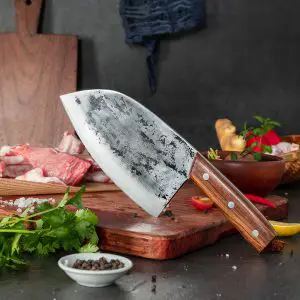
Yes, there are specific guidelines for choosing the right chef’s knife dimensions based on individual preferences. Here are a few things to consider:
Blade length: Chef’s knives typically have blade lengths of 6 to 14 inches. A longer blade is better suited for chopping and slicing large pieces of food, while a shorter blade is more agile and easier to control for tasks that require precision. If you are unsure which blade length is right for you, start with a medium-length blade of 8 to 10 inches.
Blade width: Chef’s knives also have a variety of blade widths. A wider blade provides more surface area for cutting and slicing, while a narrower blade is more agile and easier to control. If you do a lot of chopping and slicing of meat, you will want a wider blade. If you do a lot of mincing and dicing of vegetables, you may prefer a narrower blade.
Blade weight: The weight of a chef’s knife also affects its performance. A heavier knife provides more momentum, which can be helpful for tasks such as chopping through thick vegetables or cleaving bones. However, a heavier knife can also be more tiring to use, especially for extended periods of time. A lighter knife is more agile and easier to control, but it may not be as effective at cutting through large pieces of food or performing tasks that require a lot of force.
Handle: The handle of a chef’s knife is also important to consider. Choose a handle that is comfortable to grip and long enough to accommodate your hand. The handle should also be well-balanced, so that the weight of the knife is evenly distributed.
In addition to the above factors, you may also want to consider your individual preferences when choosing a chef’s knife. For example, some people prefer a knife with a straight blade, while others prefer a knife with a curved blade. Some people also prefer a knife with a granton edge, which has small scallops that help to reduce friction and prevent food from sticking to the blade.
The best way to find the perfect chef’s knife for you is to experiment and try out different knives at a kitchen supply store. See what feels most comfortable in your hand and what performs best for the types of tasks you typically perform.
How does the curvature or profile of the blade affect a chef’s knife’s performance?
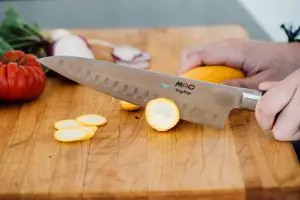
The curvature or profile of a chef’s knife blade can have a significant impact on its performance. A chef’s knife with a curved blade, also known as a rocking blade, is designed to be rocked back and forth on the cutting board to create smooth, even cuts. This type of blade is ideal for chopping and slicing large pieces of food, such as meat, vegetables, and bread.
A chef’s knife with a straight blade, also known as a slicing blade, is designed to make thin, precise cuts. This type of blade is ideal for tasks such as slicing meat, fish, and vegetables.
Some chef’s knives have a combination of a curved blade and a straight blade. This type of blade is known as a hybrid blade and is designed to offer the best of both worlds: versatility and precision.
Here is a more detailed overview of how the curvature or profile of a chef’s knife blade affects its performance:
Curved blade: A curved blade is designed to be rocked back and forth on the cutting board to create smooth, even cuts. This type of blade is ideal for chopping and slicing large pieces of food, such as meat, vegetables, and bread. The curvature of the blade also helps to reduce friction and prevent food from sticking to the blade.
Straight blade: A straight blade is designed to make thin, precise cuts. This type of blade is ideal for tasks such as slicing meat, fish, and vegetables. A straight blade is also easier to control than a curved blade, making it a good choice for tasks that require precision.
Hybrid blade: A hybrid blade is a combination of a curved blade and a straight blade. This type of blade is designed to offer the best of both worlds: versatility and precision. A hybrid blade is ideal for a wide range of tasks, from chopping and slicing to mincing and dicing.
Overall, the best curvature or profile for a chef’s knife blade depends on your individual preferences and the types of tasks you typically perform. If you are unsure which type of blade is right for you, it is best to start with a hybrid blade, which offers a good balance of versatility and precision.
Can you recommend an ideal dimension range for a versatile chef’s knife for home cooks?
Yes, I can recommend an ideal dimension range for a versatile chef’s knife for home cooks.
Here are some general guidelines:
- Blade length: 8-10 inches
- Blade width: 1.5-2 inches
- Blade weight: 8-12 ounces
This dimension range will give you a knife that is both versatile and easy to control. It will be able to handle a wide range of tasks, from chopping and slicing to mincing and dicing.
Of course, the best dimensions for a chef’s knife will ultimately depend on your individual preferences and cooking habits. If you are unsure what size is right for you, it is best to try out a few different knives at a kitchen supply store to see what feels most comfortable in your hand.
Here are some additional tips for choosing a chef’s knife:
- Choose a blade material that is durable and easy to care for. High-carbon stainless steel is a good choice for most home cooks.
- Consider the types of food you will be cutting most often. If you do a lot of chopping and slicing of meat, you will want a different knife than if you do a lot of mincing and dicing of vegetables.
- Don’t be afraid to invest in a quality knife. A good chef’s knife can last for many years with proper care.
Once you have chosen a chef’s knife, be sure to take care of it properly. Wash it by hand with mild soap and water, and dry it immediately. Sharpen it regularly using a honing steel or sharpening stone.
What role does the bolster play in the overall dimensions of a chef’s knife?
The bolster is the thick section of metal at the base of the blade, where it meets the handle. It serves a number of important functions, including:
- Protecting the user’s hand: The bolster helps to protect the user’s hand from the sharp edge of the blade. This is especially important when using a chef’s knife for tasks such as chopping and slicing, which can generate a lot of force.
- Adding weight and balance: The bolster adds weight and balance to the knife, making it easier to control and use. This is especially important for a chef’s knife, which is typically a larger and heavier knife than other types of kitchen knives.
- Protecting the blade: The bolster helps to protect the blade from damage. This is especially important when the knife is stored in a drawer or knife block, where it may come into contact with other knives or utensils.
The bolster is an important part of the overall dimensions of a chef’s knife. It plays a key role in the knife’s safety, performance, and durability.
Here are some additional things to consider about the bolster of a chef’s knife:
- Shape: The bolster can be a variety of shapes, but the most common shapes are rectangular, oval, and round. The shape of the bolster can affect the knife’s weight, balance, and comfort.
- Size: The bolster can also vary in size. A larger bolster will provide more protection for the user’s hand and the blade, but it may also make the knife more difficult to control.
- Material: The bolster is typically made of the same material as the blade, such as stainless steel. However, some bolsters are made of different materials, such as wood or synthetic materials.
When choosing a chef’s knife, it is important to consider the shape, size, and material of the bolster. The bolster should be comfortable to hold and grip, and it should provide adequate protection for the user’s hand and the blade.
Recommended:
Conclusion
In summary, Chef’s knife dimensions, including blade length, tang length, blade thickness, and blade profile, play a crucial role in determining the knife’s balance, durability, cutting efficiency, and suitability for various culinary tasks.
Choosing the right combination of dimensions depends on your cooking style and preferences, as well as the specific tasks you perform in the kitchen. Understanding how these dimensions impact a chef’s knife can help you make an informed decision when selecting the perfect tool for your culinary needs.

